#S-2 was formed from Mark's own negative emotions and personalities then it became its own character
Explore tagged Tumblr posts
Text
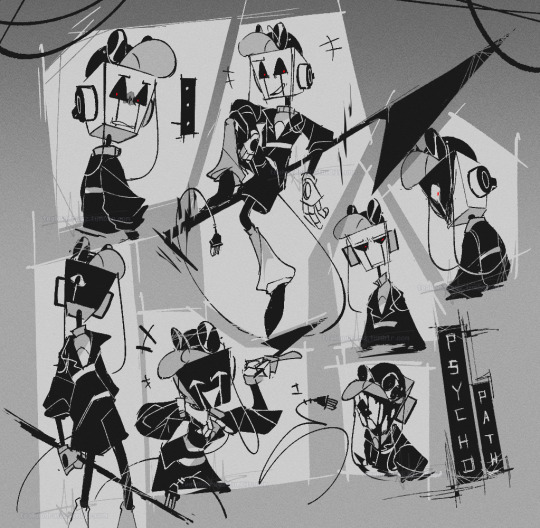
" I'm a Psycho, loving it~ "
#[album]#ask to tag#cw#Music Shot#S-2#also i just wanna mess with its expressions and poses cuz it's fun#he can turn the black face into a screenface. changing any shapes and expressions as it pleases#horror. realistic eyes. tv static. etc but he prefers the original triangle smiles more#also i'm planning to redesign S-2 right now#S-2 focuses only on killing / violence to gain LV and he's stuck that way and called it a purpose to wipe out population#He got so focus on gaining LV because it made him feel so powerful and wanted more feeling like it's the only thing that made him feel aliv#i'm okay to spoil his story and all. He's made out of human determination in Mark's body and became a split personality to him#that's why S-2 and Mark are both corrupted because they're still not compatible to each other in one body#instead of being unstable in physical form. his mind is. because Gaster used a different formula but failed again#Gaster was trying to cure Mark because he was really ill and about to die#I only took the references/theories from the original undertale amalgamation obviously#S-2 was formed from Mark's own negative emotions and personalities then it became its own character#which causes the two (or Mark or S-2 themselves) to self-loathe with each other#it's literally like looking in a window as a mirror talking shit to each other#The real good Mark in this au is Mark himself. he just needs to be set free from this misery (and need to get rid of S-2 if possible)#that's why in my old Mark death posts. S-2 was gone from self-forgiveness meaning Mark forgives himself and deserves to be happy#(because everyone don't deserve to hate themselves)#i'm gonna keep the left eye joke not being available when doing the horror screenface cuz still wanna make it a Mark thing to him#cw horror#cw eye contact
51 notes
·
View notes
Text
RWBY lore & World Building Analysis
Atlas and Mantle Part 1
Timeline, Origins, and History
Timeline
We really don’t have a coherent timeline for the series but this is my best gamble for Atlas and Mantle in terms of events and the people born there(Please RT give us an establish timeline)
B.F.B./ Before the Fall of Beacon
F.B./ Fall of Beacon/ RWBY year one
A.F.B./ After the Fall of Beacon
?-200B.F.B. People settle in Solitas for the first time
200 B.F.B. Mantle Founded
199-91 B.F.B. Century of oppression, & Alliance with Mistral
90-80 B.F.B. The Great War
80-79? B.F.B. Nicolas Schnee Born?
45? B.F.B. Ironwood Born?
28-24 ? B.F.B Ironwood attends Atlas Academy
23? B.F.B. Winter Born?
23-1 ? B.F.B Ironwood ascends to General of Atlas Military & H.M.
17 B.F.B. Weiss Born
2 B.F.B. Winters Joins the Atlas Military
0 F.B. RWBY V(s) 1/2/3
1 A.F.B. V(s) 4/5/6/7/8/9
Given from this we have a rough estimate of the timeline that concerns Atlas, and Mantle And the rise of certain characters from Atlas and Mantle. This will carry over to the next section help with the known history of this Kingdom
Origins, & History
This section is going to be a long recap of the history of this kingdom If you already know or are not interested please skip to the summary (Words in Bold should be taken as something to think and analyze upon)
Early Settlement and Rise
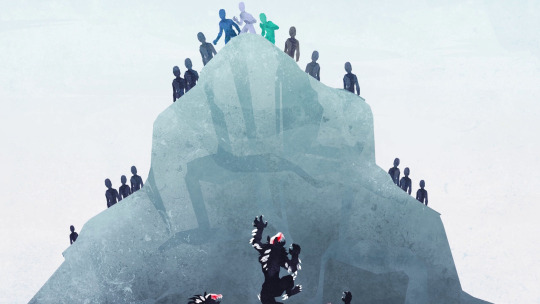
Originally founded by settlers who traveled north to the icy continent of Solitas in order to begin a new civilization. Its harsh climates and great mountain ranges helped to suppress the threat of the Grimm, but it also proved difficult for the population to grow. Humanity adapted, however, by using Dust in tandem with advanced technology, developed out of necessity and at faster progression than the rest of the world, creating what came to be known then as the Kingdom of Mantle. Their advancements in Dust application allowed Mantle to expand and devote more territory to mining and research, including the area beside the Kingdom's combat school, Alsius Academy.
Alliance with Mistral
Prior to the war, Mantle formed an alliance with Mistral. The two traded frequently, and Mantle taught Mistral how to form settlements in the snowy northern region of Anima.
Incident at Mantle

After an incident with the Grimm, Mantle came to the conclusion that, if it controlled its citizens' emotions through the abolishment of the arts and self-expression, it would become safer from Grimm. Rather than lose the alliance, Mistral did the same, to an extent. This added to the list of things Vale disliked about Mantle and Mistral, among which was the treatment of their own citizens, their use of slavery and their insistence that their way of life was what was best for everyone.
The Great War
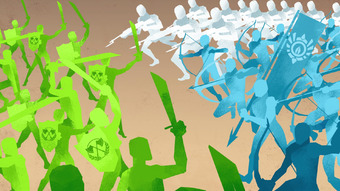
Eventually, Mistral entered a conflict with Vale, after a riot between settlers from the two devolved into the first battle of the Great War. Mantle rushed to their ally's aid, and together, they fought Vale on both Sanus and Anima soil. Having established a presence in Vacuo, the two allied Kingdoms were able to keep Vacuo out of the conflict, and some time into the war, they began pressuring the desert Kingdom to join the war on their side. Fearing that they would conquer Vacuo, should Vale fall, the citizens of Vacuo pushed Mantle and Mistral out of their territory and allied themselves with Vale.
Around eighty years before the beginning of the series, a massive ten-year conflict known as the Great War came to an end. In this war, Mantle and Mistral fought Vale and Vacuo.
During the Great War, Mantle accelerated the pace of its technological innovation, developing new weapons and applications of Dust, giving them an edge during the conflict. Large tracts of land were set aside for Dust mining and research.
Wars end and the road to reconstruction
The Great War finally came to an end with the deadliest battle in the war's history. Mantle and Mistral attempted to take Vacuo's Dust mines to cut off their enemy's supply. There, they were met with the King of Vale personally leading his army alongside Vacuo. It is said that he laid waste to countless men, but historians claim that this feat was aided by the unusually violent weather and Mantle's inexperience in desert combat.
With the war over, the leaders of the four Kingdoms gathered on neutral ground on Vytal to form a treaty and plan the future of Remnant. There, the four Kingdoms' governments were restructured, their territories were redistributed, slavery was abolished, the tradition of the Vytal Festival was begun and the King of Vale founded the four Huntsman Academies.
Atlas Academy and its secrets
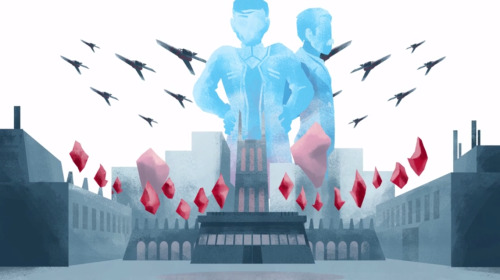
Alsius was reopened under the name Atlas Academy and was secretly given the Relic of Creation to safeguard. As a gift to the world, Atlas invented the Cross Continental Transmit System and had the towers for it built on each Huntsman Academy's campus, thus allowing all four Kingdoms to communicate. In an attempt to give back to its citizens, Mantle applied many of the techniques and technologies used in the war to enhance the Huntsman Academy's campus, expanding the school grounds and even securing the surrounding areas. Along with the eventual establishment and merging of the military and research facilities with the government and schools, the original capital of Mantle was overshadowed. The decision was made to move the capital to Atlas, and the Kingdom as a whole was also accordingly renamed to Atlas. Around this time, an incarnation of Ozma suggested to use the Relic of Creation to raise Atlas off the ground. By the present day, the public story for Atlas being kept afloat is due to Gravity Dust.
The Schnee Dust Company
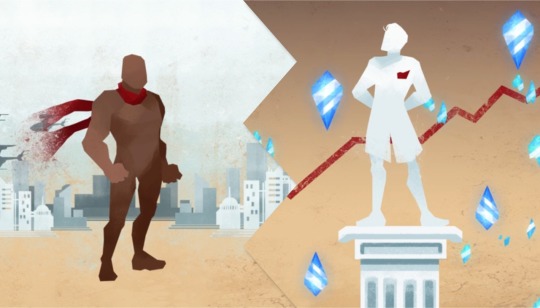
The Schnee Dust Company was founded by Nicholas Schnee in the aftermath of the Great War, in the kingdom of Mantle. Nicholas personally led numerous expeditions around the world to find Dust veins, earning him praise and respect throughout the Kingdoms, while also greatly expanding his company. However, as time passed Nicholas began to grow weary. His family missed him and his health was failing. He was convinced by his son-in-law, Jacques Schnee, to let him inherit the company. Under Jacques' leadership, the Schnee Dust Company's profits grew exponentially, albeit through less-than-ethical practices, such as the use of cheap labor, allowing dangerous working conditions, possible monopolies and having shady business partners.
The Defunct Kingdom of Mantle

The former capital of Mantle appears to have subsequently fallen on hard times,
During the charity concert , guests are heard conversing with Jacques Schnee about the economic disparity between the cities of Atlas and Mantle.
At the same time, they discuss Faunus-Human relations; it is implied that a significant portion of Faunus live in the poorer city of Mantle, and are economically disadvantaged themselves. Those that moved to the city of Atlas were "promised jobs by the Schnee Dust Company amongst others, though it is implied that this is not working out as well as the immigrants would have hoped.
The 40th Vytal Festival Tournament

Preparations for the Vytal Festival were held as early as RWBY's first semester in Beacon. Representatives of the four kingdoms converged upon Vale beginning in the second semester of Team RWBY's first year. The Atlesian contingent, including Penny Polendina and led by academy headmaster and military leader General Ironwood, arrived aboard three Airships in an impressive show of force. The Vytal Festival was marked by a stronger security presence than usual, with a sizable fleet of airships constantly overhead as well as android soldiers patrolling the grounds. This was due to the precautions of General James Ironwood, who was appointed to head of security by the Vale council following the events of "Breach", where Grimm were able to enter the city.
Unbeknownst to the populace, the matches of the 40th Vytal Festival were manipulated by Cinder Fall, who had managed to infect the Cross Continental Transmit System with a computer virus, giving her the ability to decide the match-ups in the tournament.
The festival was marred by Yang's apparently unprovoked attack on Mercury in the first singles match of the tournament. This caused widespread controversy amongst audiences. Unknown to the public, these events were also manipulated by Cinder. Emerald, working under Cinder's direction, used her Semblance to create illusions that led Yang to attack Mercury, mistakenly believing it to be self-defense. The controversy and negative emotions attracted the attention of the Grimm, which attempted to enter the City of Vale. Huntsmen and Atlas forces managed to hold them off but had to call for additional help.
Fall of Beacon

Tragedy struck, the following night, when Penny was destroyed by Pyrrha in a fatal accident, also orchestrated by Cinder, who attempted to make the accident appear like a cold-blooded murder. Cinder then took control of the broadcast with a computer virus and used it to transmit a message condemning the government. The subsequent horror and panic amongst the audience attracted even more Grimm, which managed to overwhelm the defenses that General Ironwood had set up around the City of Vale. With the Grimm attack imminent, the Festival was canceled and Amity Colosseum was evacuated.
During the 40th Vytal Festival, the hosting Kingdom, Vale, is attacked and Beacon Academy and its Cross Continental Transmit tower was destroyed, cutting off Atlas' communication with the other three Kingdoms. The festival's live broadcast and Atlas' robots were hijacked by the attackers, who made it appear as though Atlas attacked innocent civilians. Beacon became overrun with Grimm, and the presence of a petrified Wyvern drew in even more Grimm. Atlas officials searched for a solution, but with Vale making slow progress to retake the academy even after several months, they were not optimistic.
During the several months between the end of Volume 3 and beginning of Volume 4, the Atlesian council voted to place an embargo on Dust exports, in an attempt to prevent conflict, due to the other Kingdoms believing Atlas attacked Vale. This embargo continued into the events of Volumes 4 through 7.
The Present and the Fall to Come

Upon learning from Winter Schnee of a brewing threat in Mistral, General Ironwood decides to close the borders of the Kingdom of Atlas, calling back most of his troops to defend their home. He stations a small group of soldiers, lead by Special Operative Caroline Cordovin, to stay in the city of Argus and restrict transportations to Atlas.
The Atlesian Military aids in the assembly of the Amity Communications Tower, and later defends Mantle in the Battle of Mantle from incoming Grimm onslaughts. Once Ironwood declares martial law and attempts to raise the city of Atlas, the military attempts to capture Ruby's Group as an arrest warrant for them is sent out throughout the kingdom.
Summary
In this long recap we can see that the Kingdom of Atlas is one of long complicated situations and conflicts both internal and external. Both in Survival and society. The Survival aspect prior to the incident of Mantle was less about the Grimm and more of the cost of living. The Early settlers developed advanced tech to heat and insulate their homes (And Possibly burrow underground and make ice carved towns/Like Old Ba Sing Se) As well as establishing trade agreements with Imperial Mistral(Food for tech)
Now comes the social imbalance caused by this survivability. In a word where Demonic monsters drawn by negative emotions force most people to live in armed fortress cities that makes living in Remnant a very difficult task. There is very little hope to wonder whether or not you can prosper in such a world. That is until Mantle became an official Kingdom and once word spread through its trade and the rumors of security and high survivability it would not be much of a stretch for more people to migrate to what could possibly be the safest place on Remnant
Sadly it is human instinct to trade whatever we value for security and peace of mind. And in a place where the Grimm of the time can freeze to death instantly might as well be the city of angels worth any cost. An opportunity for people make a life for themselves instead of just surviving.(Huh... I wonder if their were any walking dead stories in remnant?)
But sadly this was also a crippling blow to mantle as its natural security from the Grimm attracted the desperate it also attracted the corrupted. Why I say that is because of these two lines;
Prior to the war, Mantle formed an alliance with Mistral. The two traded frequently, and Mantle taught Mistral how to form settlements in the snowy northern region of Anima.
After an incident with the Grimm, Mantle came to the conclusion that, if it controlled its citizens' emotions through the abolishment of the arts and self-expression, it would become safer from Grimm.
Why do these two line make me think that Mantle attracted the corrupt people of remnant as well as the desperate?
Well we all know by now that Mistral was a large continental empire whose power further grew thanks to mantle. And as establish the larger the territory the harder it is to control. This lack of control is why most of the bad people such as thieves and murderers go there to hide. And it continues to be like this to rwby present.
But was it truly the only territory to have such a problem. Criminals by nature are cowardly with a need of guaranteed self preservation when doing something bad. Either from local law enforcement or Grimm. And since Mistral had a trade agreement for tech interchange for food it would not be impossible for fleeing criminals to run and hide to Mantle incase Anima was no longer an option(Similar to fleeing the country(Canada or Mexico)) Sure your still a wanted person by the law but chances are you would have a higher chance of survival if you focus on avoiding the law instead of the Grimm.
And where can you go without worrying about the Grimm; Mantle Do to this it wouldn’t be unlikely that Mid- late Mantle prior to the incident would be remnants 2nd crime-ridden civilization. Just behind Mistral but just a little bit a head of Vacuo.
Which brings me to the other point
The incident in Mantle was most likely the first time that Mantles Natural security failed. And like most security systems when compromised they are either improved and fixed or replaced for something more efficient. But what caused the need for this change in security. The Grimm attack sure but the questions are; why were they there, and how did they get there?
As we know Salem can make improve or make newer Grimm types using her magic so it is quite possible that a prospering city in the frozen tundra would force her hand and she would try to destroy this kingdom to save her ego. As such she made Grimm that can withstand the cold of solitas. The one and only effective security system that Mantle had for over a century(If it ain’t broke don’t fiddle with it).
As most civilizations IRL people usually don’t change unless something unexpected happens that forces said people to improve the conditions of their lifestyle. But what would cause the people of mantle to change their lifestyle so drastically that it makes them almost robotic and inhuman.
Well as the old saying goes; Men do not fear men they fear Monsters. And when your in the only place were the monster can’t get you especially the ones that are drawn to your inner darkness, you’re pretty much free to indulge in whatever passions you deem fit. Especially if your a criminal running from law ranging from petty theft to outright murder(Serial killer in terms of tyrian). And sadly people are also entitled to an opinion, and sadly we all really don’t get along when it comes to opinions. Now what do we argue the most when our opinions clash with one another; Art and all of its medias.
Most people don’t really argue when it comes to the workplace(Unless safety concerns) or the state of other nations(unless your allies) on a day to day basis. For the most part people really don’t care or value that part of their lives mostly because they were already born in what has already established by their ancestors. So they just maintain the status quo of the functional economics of there time however they truly focus all their efforts and time into whatever passions they enjoy. But sadly as I learned through social media we really don’t get along when it comes to media entertainment( Huh as I wrote that I can’t help but wonder if the Mantle incident and the aftermath was meta foreshadowing in regards to the current state of the RT and RWBY fandoms)
Anyway Mantles soon to be outdated security and the emotions of its unchecked citizens have led to the incident that made it rethink its current defense. Something that would improve the chance of survival and make sure the people wouldn’t give into their passions.
The former can be done no problem(IRL one of the reasons why humans are the dominant species on the planet is because we like to make items that kill so other things can die instead of us) But the latter not so much. You really can’t just easily expect people to fall in line just like that or allow you to do so. But do you know what can allow you to do that; Martial Law or a Stratocracy based government(Think of the Galactic Empire)
This makes sense given the fact that Mantle had relied on natural defenses instead of practical defenses like fleets of ships or large militias. Usually when marital law is enacted it is usually a choice made by the current government to reestablish security and control over their panicked and threatened citizens. As well as to ensure that the people don’t revolt and try to replace the current government via revolution once its been made clear that the current government can’t protect its citizens. Usually Martial laws are temporary administrations. Its only when they are dragged out longer than their intended purpose do they become oppressive. So the question now stands; Did Mantles M.L. drag out longer than intended or did it evolve into a Military Dictatorship?
Either way the end result obviously didn’t end well. Not just because of the events it played during the great war but what kind of impact it had and the lingering scars that persisted into Atlas. This is easily recognized by the conflict between rwby and Ironwood when it came to the decision of whether or not to declare martial law.
The scenes in “the worst case scenario and Gravity,” when it brings up the topic of martial law paints a clear picture; this wasn’t the first time its been declared.
Obviously Gravity shows Weiss’s reaction to Ironwoods declaration. It’s almost a tear breaking expression for her and shock that it causes her to quietly say no in disbelief. Now I’m not familiar to the education system of the rich but given her ties to the SDC Atlas Mantle I would assume she is well versed in the history of her kingdom when it comes to politics/ the source of all trade between nations
Now why is that important well assuming this isn’t the first time martial law has been declared and that their have been several periods in the kingdoms history when it was declared its quite clear that it had mixed results that either were fine or dragged out longer than their intended purpose that resulted in the Great war.
A sort of progressive retraction that would not only just start another great war but would tear down all of the pillars of progress of humanity that Atlas had tried to restore. They are becoming ancient mantle once again. More robotic in nature and Inhuman except this time They had accumulated immense power and are willing to use it against anyone who stands in their way of self preservation. Since the show is clearly setting the state for a second great war much like our world wars I find it interesting that despite knowing what caused the first great war and the events that led to it. It is repeating the same mistakes of the past
(In the words of George Lucas; It’s like poetry, so that they rhyme)
Conclusion
After reviewing and giving some thought as I was researching sources and videos for this I was quite surprised by how much was shown and told in regards of the origins of Atlas.
And then comparing those findings to other works and our real world history, and societies, there is no doubt that real world Atlases and Mantles exist or have existed in our world and how they either changed for the better or fallen for the benefit of all(I’ll elaborate more in other posts about that)
But sadly Atlas is repeating the mistakes of the past and it continues to not see it. And unless the people acknowledge that they are doomed, regardless of Salem or not.
#rwby#world of remnant#rwby atlas#rwby atlas soldier#rwby mantle#james ironwood#weiss schnee#rwby ironwood#winter schnee#robyn hill#penny polendina#pietro polendina#arthur watts#jaques schnee#rwby ace ops#rwby happy huntresses#Ironwood analysis
58 notes
·
View notes
Text
How did Literary Theory came to shape?
Comprehension of literary theory many a times begets a question that what was the body of theory about literature that has existed from centuries as an underpinning for the study of literature? The answer to this question can be traced from 4th century BC when Aristotle had set the ball rolling to study literature through his Poetics. In this piece of work, Aristotle renders a defining word for the genre ‘tragedy’ while maintaining that literature is about character and the curtain that hides ‘what a character is’ is removed through his actions. Tragedy, as he puts it, should stimulate the emotions of pity and fear, which can be put as sympathy for and empathy with the scrape of the protagonist, which cause a resultant factor by dint of amalgamation of these emotions, namely ‘catharsis’ whereby these emotions are exercised as the audience identify themselves with the predicament of the central character.
Now, the second milestone in the track so instigated was embedded by Sir Philip Sydney. He belonged to a religious age which was chary of accepting any kind of fiction and poetry, and it had so framed its beliefs that it would identify these practices of writing as evil, the work of the devil. In such an age he took a valorous step by letting his work Apology for Poetry (1580) see the light of the day. He was bent to stretch the horizons of the definition of literature that was first rendered by the Latin poet Ovid (43 BC- AD 17), which is docere delictendo – to teach by delighting. Sydney also quotes Horace (65 – 8 BC) to the effect that a poem is ‘a speaking picture, with this end, to teach and delight’. The study of literature, here, renders a central position to receiving of pleasure unlike philosophy which is uplifting but do not allow space for fun. Sydney’s aim was trailblazing; he wanted to distinguish literature from other forms of writing on the rationale that literature’s primary purport is rendering pleasure to the reader, and any moral or didactic element is either subordinate to it or at least unlikely to succeed without it.
Now, here comes the time for the third milestone to be cognised. This step towards the evolution of theory had been taken by Samuel Johnson way down in time, in the eighteenth century. He marks the commencement of the tradition of practical criticism in English, since he is the first one to offer a detailed commentary on the work of a single author. His Lives of the Poets and Prefaces to Shakespeare can be viewed as majorly contributing to his idea stated above. Prior to Johnson it was only the Bible and equivalent books of other religions that were subjected to such an intense scrutiny.
The fourth milestone on this road was embedded by the major thriving of critical theory in the works of the romantic poets, namely William Wordsworth, S. T. Coleridge, John Keats and P. B. Shelley. One of the indispensible contributions in this regard is Wordsworth’s Preface to Lyrical Ballads which blends high literature and popular literature, as it encapsulates literary ballads constructed on the model of the popular oral ballads of ordinary country people. It renders space for the new idea that poetic language should be much like the language of prose avoiding the conventions of diction and verbal structure that had held dominion for so long. It also drags attention to the issue of the relationship between ‘literature’ and other kinds of writing.
The other essential work from the Romantic era was Coleridge’s “Biographia Literaria”. Much of the space that it occupies explicitly addresses the idea contained in Wordsworth’s Preface. He gainsaid the notion that the language of poetry must strive to become like the language of prose, and the major way to entertain the readers, according to Coleridge, is through the language in which the text is written; it entertains via its fictive qualities which become the source of aesthetic effect.
P. B. Shelley’s A Defence of Poetry (1821) reckons that poetry is essentially engaged with ‘defamiliarisation’, since, according to him, poetry purges from within us the view of familiarity and compels us to feel what we perceive and imagine what we already know. This phenomenal critical document foretells T. S. Eliot’s notion of impersonality put forward in his essay, ‘Tradition and the Individual Talent’ (1919). It also gives a hint of Freud’s idea of mind as made up of conscious and unconscious.
The concept of unconscious is very often found in Romanticism and is implicit in everything written about poetry by another key figure, John Keats. He did not formally write about literary theory but reflects on poetry in his letters, for instance in a letter to Bailey of 22 November, 1817, he writes that the simple imaginative mind may have its awards in the repetition of its own silent working coming continually on the spirit with a fine suddenness. Here, the silent working of the mind is the unconscious and the spirit into which it erupts is the conscious. Keats’ notion of negative capability also records unconscious as paramount.
After the Romantics the next milestone was embedded by the work of mid and late Victorians: George Eliot, Matthew Arnold and Henry James.
The focus on the concept of ‘close-reading’ in the 1920s had partly popped up from the works of Matthew Arnold. He remained a crucial figure in the history of English criticism.
He feared that the atrophy of religion would leave a cleaved society with no common system of beliefs and values, and this would be a potentially disastrous consequence. Thus, he came up with a solution that literature can be a possible replacement for religion in this regard and also weened that the middle classes on whom the responsibility of democracy majorly fell, had been debased by materialism and philistinism. So this became the apt timing for the critic to jump in and help people in cognising the best that has been known and thought in the world and therefore, it enlarged their capacities to identify and approbate the canon of great works that had been carved out of the wisdom of the ages. Arnold seems to be bringing to sunshine the advocacy that he had for the amateur. According to him, if one has not read everything but have read the best and is able to pen down its qualities, then he can have the confidence to write and reach a true judgement on it. This veering change announced a direct relationship between the reader and the great literary works/writers.
His momentous thoughts are found in the essay titled The Function of Criticism at the Present Time and The Study of Poetry. He has brought to prominence the conviction that literature must remain disinterested that is, politically detached and uncommitted to any specific action, and the motive behind literary criticism is to attain pure and disinterested knowledge which in his terms is to see the object as in itself it really is.
His key literary-critical device is the idea of ‘touchstone’ where he advocates that there must always be in mind the lines and expressions of the great masters and they must be applied as a touchstone in framing critical appreciations of other literary works in order to render a ‘real’ rather than a ‘historic’ or a ‘personal’ stance.
The next salient contribution in the canon of critical ideas has been made by T. S. Eliot, and his prime formulations are:
1. Dissociation of Sensibility – Eliot coined this term in his review article on Herbert Grierson’s edition of The Metaphysical Poets in the seventeenth century where he backed the idea that thought and feeling must be separate.
2. Poetic Impersonality – Eliot developed this term in his two-part essay, Tradition and the Individual Talent. This term can be viewed as his way of deflecting the contemporary thinking about poetry from the ideas of originality and self-expression which were raised to prominence by Romanticism. More than perceiving poetry as a mere outflow of emotions and personal experience, he saw it as transcending of the individual by a sense of tradition which spoke through, and is transmitted by, the individual poet. Hence, there is a fine line of distinction between the mind of the individual, the experiencing human being and the voice which speaks to the readers.
3. Objective Correlative – This is a notion developed in the essay On Hamlet, which is the encapsulation of English empiricist attitudes. According to objective correlative, the best way to show emotions the doors in art is through gesture, action or concrete symbolism rather than approaching it implicitly. This runs, perhaps, parallel with the ancient distinction made by Plato between mimesis and diegesis.
Finally comes in the last name on the list which is F. R. Leavis, the most influential British critic prior to the theory movement. He also, like Arnold, saw that the study and appreciation of literature is a pre-condition to the health of society. For him, the abstract thoughts were insignificant and he wanted to look for a system which would by-pass fixed criteria. Like Arnold, he turned down attempts to politicise either literature or criticism implicitly. But, he differed from Arnold too as he took the past great writers more or less for granted. He composed essays, radiating the essence of his method, which hit the reputation of some major established figures.
Leavis began as an admirer of T. S. Eliot’s critical works but he steered clear of shaping out critical vocabulary and deployed terms and phrases which already had set meanings. For him, what makes a work worthy is its conduciveness to life and vitality. In 1932 he founded an important journal called Scrutiny along with his wife, Q. D. Leavis, which they produced together for twenty-one years. As the title itself suggests, it extended the ‘close-reading’ method beyond poetry to novels and other materials. He can be reckoned as a combination of Samuel Johnson and Matthew Arnold because he offered former’s moralism and the latter’s thoughts concerning society.
4 notes
·
View notes
Text
Images of Females Advertising Dove
Dove has been around for decades since the 1950’s and it has changed its marketing style since launched. Dove in the beginning had only white faces and today its very diverse. Dove now aims towards diversity and produces products for different skin types. Within the last two decades the brand has promoted positive body image, became more diverse in terms of ethnicity, gender, and race. From the beginning where the models were white and thin until present time, where we have a host of many beautiful shades and sizes of women.

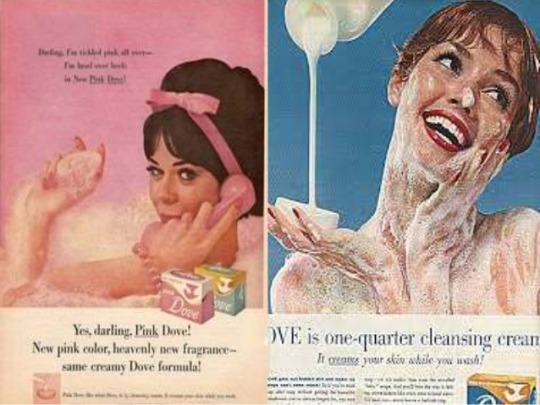
“The Use of Black Models in Advertising” This article was published in 1971, the article was about the reasons why black models are used for advertising. According to the article black models are used in marketing to sell products to black people. After the civil rights movement and new laws created in the legislature, marketers had to prepare for a new world in which black people would have a voice and more money to buy their products. As well as whites realizing that “black money” is the same as “white money”, both are green; so, with that realization, white businessman became smarter and began marketing black people in positive light for profit.
In the 1950’s concerning size, women were more concerned about having a slim figure, the ‘ideal’ size for attracting a man; Most ads you see on tv or in the magazines/newspapers in the 20th century would be of a slender sized woman, in addition, everyone was attracted to that size. Most of the advertising from the 50’s to the 70’s lacked people of color and of plus sized. I noticed that they choose light skinned black women over dark-skinned black women. As time passed, they began implementing dark skinned women. Marketers usually produced what they felt would sell and what attracts people to buy their products. The secret to advertising is subliminal messaging; subliminal messages is to gain favor with the consumer you’re targeting. For instance, if marketers placed more curvier women in their ads the world would be more accepting.
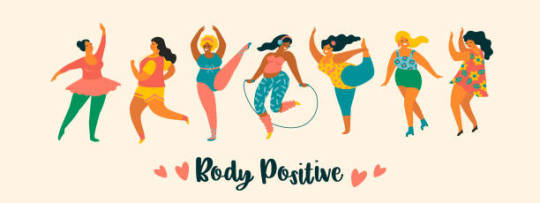
The early 2000’s Mo’nique (comedian/actress) sort of pushed away the fat shaming when she glorified her size. Mo’nique made ‘fat’ girls feel more beautiful and accepted. In 2005 She hosted the first televised beauty competition and boot camp for full-sized women “F.A.T. Chance,” on the Oxygen station. Mo’nique encouraged other plus size women to love the body they’re in and that they too are normal. “With its debut in 2005 it was the highest-rated original show in the company’s history, and in the second season it had a total of 4.8 million viewers for the premiere and its encores” (Luckily, There’s Plenty of Her for Everybody). There's a market for plus sized women just as there is for ‘regular’ sized women. The views on that show proved that people are interested in a plus sized/curvy woman's lifestyle also people support the body images. The ratings definitely boosted confidence in other plus sized women. Everyone comes in different sizes and should love every inch of themselves and only change for themselves, and of course for a healthier you. “Women are more than the labels that are given to us, they're more than an age, more than a size, more than a name...” (Dressbarn Launches an Empowering Campaign Starring Ashley Graham).

You’d be surprised the amount of negativity and pressure women endure daily, in terms of body image. Super model Tyra Banks has been shunned for her body a few times in her modeling career. It has become so bad that it took a toll on her career. “Banks said her desire to be her own boss came from rejection she faced for her skin color and curvier figure, which she said was not desirable in the world of high-fashion modeling. “Me being a boss came from pain,” she said. “Being told no you can’t.” ...” Those experiences “created in me an empathy for women and physical discrimination,” (Tyra Banks on Body Shaming in the Fashion Industry: ‘My Pain Turned Me Into a Boss’). Banks kicked off her own show “Americas Next top Model”, there she featured models of many sizes and ethnicity's. She also featured women who were more on the heavy side, also known as ‘plus sized’. Banks also bridged the way of women flaunting, loving their bodies no matter their size. “Body-positive advertisements often feature individuals helping others recognize their inner beauty, and these images of support and kindness could potentially evoke elevation in audiences” (Feeling Bad About Feel-Good Ads: The Emotional and Body-Image Ramifications of Body-Positive Media).
youtube
In 2017, Dove offered a Nigerian lady Lola Ogunyemi, to be the face of a new body wash campaign. Lola was excited for the Opportunity, stated, “Having the opportunity to represent my dark-skinned sisters in a global beauty brand felt like the perfect way for me to remind the world that we are here, we are beautiful, and more importantly, we are valued” (I am the woman in the 'racist Dove ad'. I am not a victim), however the commercial sparked a lot of negative backlash due to the content of the advertisement. Due to all the negative comments and controversy around the ad, it was removed, and Dove apologized if they came off as ‘racist’. Besides the backlash the brand has received, I thought it was a great opportunity for Dove to display a dark-skinned person and show the world that dark skin women are real, and beautiful.
“I know that the beauty industry has fueled this opinion with its long history of presenting lighter, mixed-race or white models as the beauty standard. Historically, and in many countries still today, darker models are even used to demonstrate a product’s skin-lightening qualities to help women reach this standard” (I am the woman in the 'racist Dove ad'. I am not a victim).
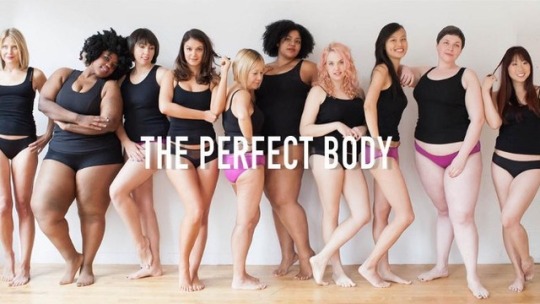
Although women are still body shamed and go to extreme measures to get the ‘perfect’ body Dove has launched a “Real Beauty campaign”, encouraging people all over the world to flaunt their imperfections and love themselves. “...viewing body-positive advertisements, as compared to traditional beauty ads, sparks stronger emotional responses, including both positive and negative emotions” (Feeling Bad About Feel-Good Ads: The Emotional and Body-Image Ramifications of Body-Positive Media). Under the Real Beauty campaign is the “Self Esteem Project”, “According to the research, 61% of girls between the ages of 10 and 17 in the U.K. lack confidence and body esteem, while nine in 10 girls with low body esteem are likely to put their health at risk trying to conform to what they believe is expected of them. Dove is spending 1.5 million pounds on the campaign, which also offers free advice and support around the issues of self-esteem on the Dove web site” (Dove spearheads ‘Self Esteem Project’ to salute and honor real girls). Dove works with non-professional models to help with the campaign to help build positive body confidence in the girls.

Over the past few years Dove has been pushing towards more diversity and knocking out beauty stereotypes. Dove works with people nationwide from infants to elderly people from shades of lighter skinned to shades of darker skins. Big, small, short, tall, slim, hefty, you name it, all types of people. People with physical disabilities, skin conditions i.e, vitiligo. People with ‘bad’ acne, crooked teeth, missing teeth, birth marks, nappy hair, straight hair, short hair, long hair, locked hair, a whole variation of people. Size and color of skin doesn’t define you, when you look at yourself in the mirror you should love every inch of yourself, and if weight is an issue that bothers you, get in the mind set of changing your weight. I just want everyone to know we all are beautiful in our own way.

On their website, Dove welcomes everyone and gives you a feel of comfort that purchasing their product would be one of the best decisions you’ve made in terms of beauty. “Welcome to Dove…the home of real beauty. For over a decade, we've been working to make beauty a source of confidence, not anxiety, and here's where the journey continues. Beauty is not defined by shape, size or color – it’s feeling like the best version of yourself. Authentic. Unique. Real. Which is why we’ve made sure our site reflects that. Every image you see here features women cast from real life. A real life version of beauty...” (Dove). Dove is displaying that there are different forms of beauty.

I love the approach that Dove has taken, it’s allowing the younger generations to see that they are beautiful and that the models they see on tv are superficial, yet the models are beautiful as well. Society has deemed being ‘fat’ to be ugly! Being darker skinned to be ‘ugly’! Being gay abnormal! The beauty campaign of Dove has helped millions recognize that you can look pretty without any makeup and you can love yourself no matter what condition you’ve been diagnosed with. You can still relate to others because we all have imperfections.

Society today has left many of us questioning our true selves. "Am I too fat?", "Am I really ugly?" , "Will I be accepted regardless of my sexual orientation?". Despite pondering our insecurities, DOVE has helped many people like you & me recognize our natural beauty. From my personal experience, using DOVE has made my skin feel so radiantly beautiful which has reflected beauty in my self image. Using DOVE has not only allowed me to recognize the beauty in myself but also in the beauty that would open up to those around me. The DOVE campaign demonstrates a relatively natural use of soap that encompasses beauty and self-image. This soap has a diverse ability to help make us appreciate both our physical and mental forms.
youtube
youtube
youtube
References
Kraus, A., & Myrick, J. G. (2018). Feeling Bad About Feel-Good Ads: The Emotional and Body-Image Ramifications of Body-Positive Media. Communication Research Reports, 35(2), 101–111. https://doi-org.libserv-prd.bridgew.edu/10.1080/08824096.2017.1383233
JOHN J. WHEATLEY. The Use of Black Models in Advertising. Journal of Marketing Research, [s. l.], v. 8, n. 3, p. 390, 1971. DOI 10.2307/3149585. Disponível em: http://search.ebscohost.com/login.aspx?direct=true&db=edsjsr&AN=edsjsr.10.2307.3149585&site=eds-live. Acesso em: 26 nov. 2019.
“Dove Spearheads 'Self Esteem Project' to Salute and Honor Real Girls.” Los Angeles Times, Los Angeles Times, 27 Dec. 2017, https://www.latimes.com/fashion/la-ig-wwd-dove-self-esteem-project-20171227-story.html.
Lee, Felicia R. “Luckily, There's Plenty of Her for Everybody.” The New York Times, The New York Times, 5 Aug. 2007, https://www.nytimes.com/2007/08/05/arts/television/05lee.html.
Lopez, Ricardo. “Tyra Banks on Body Shaming in the Fashion Industry: 'My Pain Turned Me Into a Boss'.” Variety, 6 June 2018, https://variety.com/2018/film/news/tyra-banks-on-body-shaming-in-the-fashion-industry-my-pain-turned-me-into-a-boss-1202834241/.
Ogunyemi, Lola. “I Am the Woman in the 'Racist Dove Ad'. I Am Not a Victim | Lola Ogunyemi.” The Guardian, Guardian News and Media, 10 Oct. 2017, https://www.theguardian.com/commentisfree/2017/oct/10/i-am-woman-racist-dove-ad-not-a-victim.
“Welcome to Dove.” Dove US, https://www.dove.com/us/en/home.html.
Williams, Lashauna, and Lashauna Williams. “Dressbarn Launches an Empowering Campaign Starring Ashley Graham.” InStyle.com, 7 Dec. 2019, https://www.instyle.com/fashion/ashley-graham-dressbarn-more-than-a-name-campaign.
4 notes
·
View notes
Text
Jodi Arias and Travis Alexander

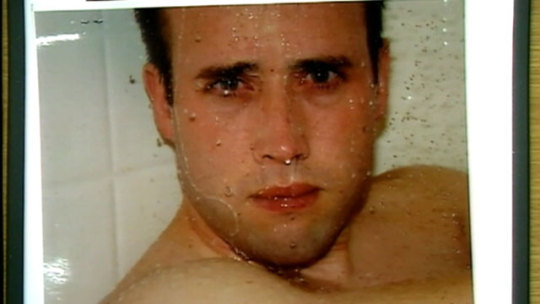

It is no secret that long distance relationships are difficult, especially when you become attached to that person so quickly. And when it ends and you're forced to lose that attachment, this can be even harder. However, Jodi Arias was someone who reacted to this terribly, resorting to extreme methods to enact her form of justice. The murder of Travis Alexander at the hands of his ex-girlfriend is an infamous case amongst social media, due to the behaviour exhibited by the perpetrator and the shocking violence of the crime.
Jodi Arias was born on July 9th, 1980 in Salinas, California, the second eldest out of 5 children, to William Angelo and Sandy S. Arias. Jodi claims that from the age of 7, she was the victim of child abuse and would be hit with a belt and wooden spoons. A babysitter recalled that, at the age of 5 and 6, Jodi Arias had hit her younger brother with a baseball bat and claimed that she did not know what had happened. When she was a teenager, her parents found out about her growing marijuana plants in her bedroom and called the police on her. Jodi left home at 17 and dropped out of high school in 11th Grade. She worked as a waitress in multiple restaurants – one of these jobs involved her eventually dating the food and beverage manager Darryl Brewer. They bought a house together and paid $2800 each in mortgage payments. She later went on to get a job at LegalShield while balancing her waitressing job and became involved with the Mormon Church.
Travis Alexander was born in Riverside, California, to Gary and Pamela Alexander on July 28th 1977. In a Blogspot post written in 2008, Travis claimed that his parents were drug addicts and that his father was never around. His mother allegedly would beat them for minor issues, such as waking her up. At age 11, he moved in with his grandparents, who introduced him to the Mormon Church. Alexander became a devout Mormon from there on. He went on to become a salesman and a motivational speaker for LegalShield.
At a LegalShield conference in Las Vegas, Nevada, in 2006, Jodi and Travis met for the first time. According to Jodi, there was immediate attraction between the couple and the relationship turned sexual after a week. For a year and a half, they would have an on and off relationship, where they would travel between each others houses in Arizona and California to meet. Jodi would even go so far as to become baptised in Travis' church and even moved to Mesa to become closer to him. However, friends of Travis say that they had a very negative opinion of Jodi and found that her behaviour was quite worrying.
In June 2007, the couple ended their relationship for good, although they continued to have multiple sexual encounters with each other. Alexander did officially start dating other women, claiming that he wanted to officially settle down and find someone he could marry. However, strange behavioural patterns started occurring in his and his partners lives. On two occasions, his tires had been slashed and he and his partner would repeatedly be sent threatening anonymous emails. Travis allegedly told friends that he suspected Jodi to be the culprit behind all of this, even climbing in through his dog flap when he was sleeping. In 2008, Travis had enough after suspecting that Jodi was hacking into his social media and bank accounts, ending their relationship for good and cutting all ties with her.
Although Jodi was originally going to be joining Travis on a work trip to Cancun, Mexico, he asked if he could change his travel companion to another female friend. On May 28th, there was a break-in reported at the residence of Jodi's grandparents house, where she was living – one of the missing objects was a .25-caliber automatic Colt pistol. After multiple phone calls between the two and dyeing her hair brown, Jodi rented a car and drove to Alexander's home in Mesa, Arizona on June 2nd.Although surprised to see her, the two ended up having sex, taking photos of themselves whilst in the act. Jodi ended up returning home on June 4th and returned the rental car. This would be the last time any of Travis' friends would hear from him.
After not hearing from Travis for a week, a group of friends turned up at his house, concerned when he missed an important meeting and failed to show up for the work trip to Mexico. His roommate believed he was out of town, due to his bedroom door being locked. However, once they looked inside, they found Travis dead on the floor of the shower. He had his throat slit, a gunshot to the brow and 27 stab wounds, with defensive marks on his hands. His death was officially ruled as a homicide.
While searching his apartment, police found a digital camera in the washing machine, a .25-caliber round with a shell casing to match, and a bloody handprint in the wall of the shower. The .25-caliber shell matched with the gun and shells that had been stolen from Jodi's grandparents a few days before. Friends of Travis also reported to police that Jodi and Travis had a very tumultuous relationship, with Jodi even stalking him. Police were able to recover the deleted photos on the digital camera, which showed photos of them in sexually explicit positions, taken at various times on June 4th. The final photograph showed Travis on the floor, bleeding profusely. The handprint on the wall was tested for DNA, which was found to be a match to both Travis and Jodi. Associates of Jodi also noted that when she returned the rental car, she had various scratches on her hands.
On July 9th 2008, Jodi was indicted on charges of first-degree murder and was arrested on July 15th. She was extradited to Arizona and pleaded not guilty to the charges. In interviews with the police, she claimed that she had not seen Travis since April of that year. However, after realising that the police knew that they had been together the day that he was murdered, she changed her story and claimed that two intruders had broken into his house and murdered him. She was also seen acting strangely on the CCTV footage when the interviewers left the room for a period of time, such as singing to herself and doing handstands. Two years after her arrest, Jodi finally admitted to the murder, claiming it was in self defence and alleging that she had been the victim of domestic violence.
The trial on Jodi Arias commenced on December 10th 2012, four years after Travis' murder. She was deemed competent to stand trial and agreed to take the stand in her own defence. Her defence team used the claim that Jodi was a victim of domestic violence during the trial and that she only killed Travis in self defence. Jodi answered questions on the stand for 18 days, making allegations that she was abused by her parents and painting Travis to be a physical and emotional abuser. Phone conversations between her and Travis were played, many of which had been recorded without Travis' knowledge – some of these tapes included graphic sexual detail, as Jodi claimed she wanted to use the tapes to embarrass him in front of his church. Jodi Arias also claimed that Travis found young boys girls sexually attractive and that he was a pedophile. The relationship reached its climax when she had supposedly dropped his camera and he became enraged. However, multiple others who were called to testify denounced many of these claims against Travis. Many did not believe her accusations, even comparing her to Casey Anthony, who accused her father of sexually abusing her as a child.
On May 7th 2013, after many contradictory statements in her statements and overwhelming evidence against her being presented, Jodi Arias was found guilty of first degree murder, with every member of the jury in agreement over her guilt. During the sentencing phase, two different juries were in deadlock over whether Jodi should be given a life sentence or a death penalty. Eventually, the decision was handed over to the judge over the case, and he sentenced her to a life sentence without the possibility of parole. She is currently at the Arizona State Prison Complex and is a high risk level 5 prisoner. She is under maximum security and has been creating art to earn money.
#jodi arias#travia alexander#true crime#tcc#tcr#informational#own post#true crime research#true crime community
46 notes
·
View notes
Text
Wohoo! hi guys its been a long while! hope y’all are safe and protecting yourselves against COVID-19. let’s sanitize more and wash our hands frequently to avoid contracting the disease but above all lets STAY AT HOME. Anyways, since schools have been closed down because of the pandemic, my school moved to we having online classes to prevent us being idle while the whole word takes a major turn. The questions are below. I took my time to research and watch series of videos to help me come at my answers and conclusions. I hope they are useful to you too.
1. Write in your own words a brief history of photography and the major proponents of the practice.
2. Will you regard photography as an art or science?
3. How is photography relevant to human history?
1.
· Photography was born from the camera obscura invented in the 1830’s but in some 200 years ago the camera developed from a box that took blurry pictures until around 11th century when obscura was invented by Iraqi scientists. Photography captured a slice of life, it told something about the person or whatever that was captured. Examples are the picture of Monna Lisa, the night watch and so on. At first, photography was either used an aid in the work of a painter or followed the same principles painted followed. According to Ken Whitmire, photography was inherited from painters a 100 or 200 years ago.
· The camera obscura manuscripts and principles on how it works was invented in 1021 by Ibn al-Haythan, known as Alhazen. The camera obscura is a dark closed box with a hole at one side of it. It is stated that around 1553, that Giovanni Battista Della Porta was the first to use the camera obscura or wrote an essay on how to use it.
· Shortly before 1800 (exact date not known), Thomas Wedgewood, one of the first people who tried to use the concept and make it permanent. He used silver nitrate on paper and white leather but achieved better results with white leather.
Thomas was the son of the famous Josiah Wedgewood, the potter, and he wasn’t all that successful into making the image into light. He would get the image but it would get destroyed because it was not fixed like how it is done in the darkroom.
· The first permanent and oldest surviving photograph, was taken by a French inventor Joseph Nicephore Niepce, it records a view from the “Window at Le Gras”. The exposure lasted for eight hours. Niepce came up with the idea of using petroleum derivative called “Bitumen of Judea” to record his camera’s projection. In the next few years he partnered with Louis Daguerre and they started working together till Niepce died. The first ever picture to have a human in it was Boulevard du Temple by Louis Daguerre, taken in 1838. The first known picture with a 10 minute exposure of a man having his shoes polished.
· Finally, after decades of improvements, cameras began to earnest with Eastman’s Kodak’s cameras. In 1888 he sold his first commercial camera. It took only black and white shots.
· In 1939, Sir John Herschel came up with a way of making the first glass negative. The same year he coined the term photography, derived from the Greek word “fos” meaning light and ‘grafo” meaning write.
· Colour photography was explored throughout the 19th century but wasn’t really viable till the middle of the 20th century. Several methods were patented by Louis Ducos du Hauron and Charles Cros. The first colour photo, an image of a tartan ribbon was taken by James Clerk Maxwell, a famous Scottish physicist.
· In 1939, WWII helped shape photography. The Wehrmacht recruited photographers for its propaganda campaigns. As a propaganda tool, the camera became a weapon in the hands of soldiers.
· In 1948 Polaroid introduced an instant image development invented by Edwin H. Land. It is a type of camera which uses self-developing film to create a chemically developed print shortly after taking the picture.
· In 1991, first professional camera was announced by Kodak professional DCS.
· In 2000 the first camera phone was invented by Sharp Corporation.
2.
The technicality of producing an image is science but the composition and generating a beautiful image is art. Even though the science of photography is the following of series of steps when editing and making adjustments and the organized body of knowledge and principles, I think photography is an art because art is an expression of feelings brought into words, pictures (photography) or acting. Or art is something that is created with imagination and skill and that is beautiful or that expresses important ideas or feelings. This definition shows that photography possesses everything to be an ideal medium for creative expression, thus, art.
Photography is an art because it is a continuation of the art of drawing or painting. Photography is just like painting in the sense that although it does take accurate pictures of reality it allows for some modification. Photography captures a slice or a moment of life in every photograph that is taken and all of this symbolizes art. How certain people did certain things and other iconic photographs. Pictures of people like Monna Lisa, the snake river etc. all show art.
As any visual art form, photography allows for an expression of emotions. It exploits vulnerabilities of the human visual perception and can make us experience emotions that move us and compel us to do things we otherwise would not even think of. It is Jessica Lange’s series of photos showing inhumane conditions on American factories that made the lawmakers enact Child Labor Law, it is Carleton Watkin’s landscapes that were the reason for Abraham Lincoln signing the first federal government act to preserve a part of nature for the common good now known as Yosemite National Park.
Photography requires perfection through practical knowledge, creativity and personal skills. Practical knowledge is knowledge that is acquired by day-to-day-hands-on experiences. Practical knowledge is gained by doing things. If you want to be a good manager for example, one needs several years of experience, same applies to photography. One needs to practice to become a pro at photography. Speaking of creativity, it is the use of imagination or original ideas to create something, thus, what a photographer plans on bringing out with his photo, that is the message he or she wants to convey to whoever his audience is, the theme, the story, the poses etc. The science part of photography or the body of knowledge and principles and series of steps don’t guarantee one creative. Theoretical knowledge, which is gained for example by reading manuals is not sufficient since every art requires practical knowledge.
Photography is an art because of the fact that it does take an artist’s eye to find a great subject for digital photography. The photographer conveys messages (photos) through aesthetics; a set of principles concerned with nature and appreciation of beauty. It deals with questions of beauty and artistic taste. Questions like;
· How long did it take me to plan this photo shoot?
· How does this photograph make me feel?
· What’s the lighting like in this particular photograph? Is it artificial or natural? Controlled or spontaneous? A photographer answers these questions by means of art and not by a series of steps or the acquisition of knowledge by reading a manual or experimentation and observation. Managing the job requires certain skills which are personal possessions.
The above listed and elaborated points are the reasons why I strongly think photography is an art.
3.
Photography is relevant to human history in a sense that it is part of our legacy. Photography freezes moments of our lives which pass unremarkably and which seem to have little importance to us at that time. The significance however, may be for others who search for the person we once were or the places we once knew. They can be small pieces of jigsaw that completes the larger picture of our lives.
Furthermore, photography is relevant to human history because it aids in communication. People all over the world can’t read and write and the few that can comprehend more than 250 words per minute. As a result, photography has taken a leading role in communication and is very inevitable.
Photographs play a vital role in human history by connecting us to our past. They remind us of people we’ve known and still do, the places we’ve been to, the feelings we’ve felt; love, pain, hatred, fear etc. and they tell our stories too.
Photographs can be a vital memory clue. They help us know who we are; the type of fashion or fashion sense during the old days, the kind of vehicles or other technology depicted. They also tell where we’re from, where we’re headed, the people we came from, our ancestors etc.
Another relevance of photography to human history is information. Some photographs contain very vital information about very important things and places or people. Photographs disseminate information about humanity and the society. The vital information was mostly recorded at the back or the reverse side of those old or ancient photographs and they mostly contained symbols, marker’s marks etc. an example is the carte de visite photograph from 1883. The scan of the back reveals information about the image.
Photography is relevant to human history because it keeps history alive. Most of us weren’t alive or born when certain photographs were taken but through these same photographs we’ve been able to learn about the history of particular people that were captured, particular iconic photos, why they were captured and a whole lot. For example, I wasn’t around the first permanent photograph ever (Boulevard du Temple by Louis Daguerre, taken in 1838) was taken but thanks to photography keeping history alive, I’ve been able to learn about it and see the actual picture and the photographer who captured it even though I wasn’t around to witness it. Photographs make us see and believe history.
Photography helps us understand human history and culture and this is also another reason why photography is relevant to human history. It is much more than a simple record or a snapshot. It speaks to the best and most generous part of our human nature.
Everything we do and everywhere we go is recorded because they matter. Some moments and experiences cannot be forgotten and so we keep them through photographs.
Basic Photography
DOREEN WORBIE.
0 notes